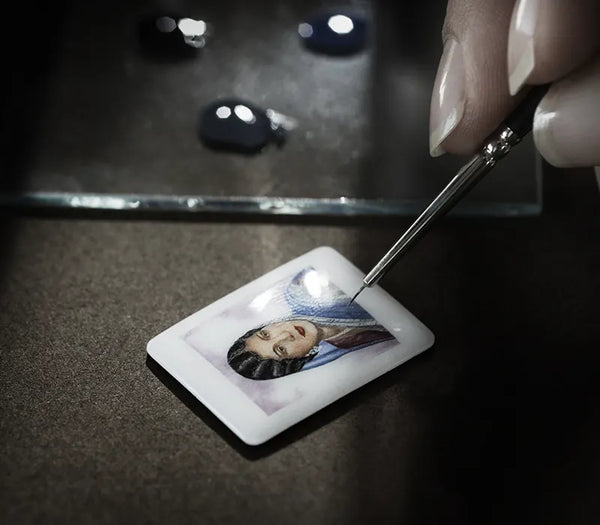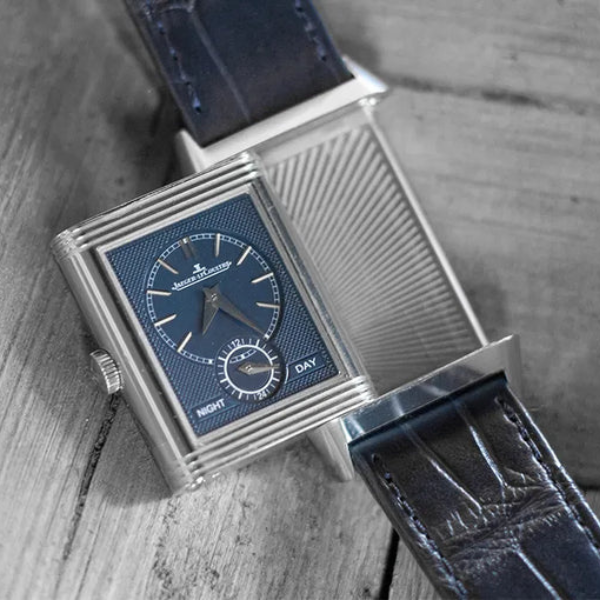
Looking to give the ultimate expression of prestige this holiday season? Or maybe a highly personalized gift to your significant other? We’ve got you covered. Jaeger-LeCoultre’s Reverso has been the envy of many watch collectors for decades because of it’s ingenious engineering and classic design. With a single flip, the watch reveals another face – another time zone, a skeleton back, a personal message or a picture. You can even engrave or enamel it, making the Reverso truly a watch of your (or their) own. The 1930’s art deco inspired masterpiece was ahead of its time when it was created and has been the highest example of prestige and wealth ever since.
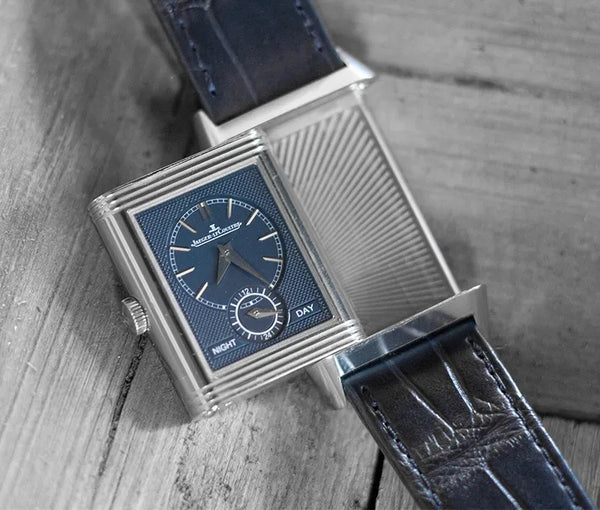
The History of a Masterpiece
The story of the Reverso watch pre-dates the story of Jaeger-LeCoultre by just a few years, which is why the name of the manufacture does not appear on the dial of the original 1931 model. Jacques-David LeCoultre and watchmaker Edmond Jaeger had been collaborators since 1906, but their companies remained separate until they officially merged to form Jaeger-LeCoultre in 1937. However, in 1930, César de Trey, a wealthy dental tool salesman from London, approached the two with an intriguing opportunity.
De Trey returned from a trip to India, where he observed how fragile wristwatches were when exposed during sports such as polo (crystals and dials would shatter due to contact with wooden mallets and balls). He was challenged by a group of British army officers to see if watchmakers in Switzerland could find an elegant solution that would allow players to enjoy the sport while keeping their prized timepieces intact.
While Jacques-David LeCoultre developed the watch’s movement, de Trey enlisted the help of French designer René-Alfred Chauvot to design the case. Her solution was to design a wristwatch that could slide on its base and flip over on itself thus protecting the case against blows to the wearer’s wrist. Chauvot was inspired by architecture and influenced by, what was then, the Art Deco era. She designed the case to have rectangular lines and follow the rules of the golden ratio, the most aesthetically pleasing ratio of the sides. In addition, the three signature lines at the top and bottom of the Reverso’s dial are gadroons, a decorative motif consisting of a series of convex curves, which were emblematic of the Art Deco movement. Chauvot submitted a patent application for his invention on March 4, 1931 and on July 25, 1931; de Trey bought all rights to Chauvot’s invention.
 Images courtesy of jaeger-lecoultre.com
Images courtesy of jaeger-lecoultre.com
Jaeger did not produce rectangular cases at the time. So, after purchasing the rights to Chauvot’s patent, César De Trey launched Specialités Horlogères with Jacques-David LeCoultre. Their new venture would manufacture the revolutionary design using parts made by specialists. The cases were made by A.E. Wenger and the movements by Tavannes. In 1933, LeCoultre introduced in-house movements intended specifically for the Reverso including Caliber 410, 411 and 404 (a smaller movement intended for ladies).
The Reverso caught the attention of affluent collectors, not just polo players. Chauvot’s design perfectly encapsulated the era’s obsession with Art Deco design and combined practicality with personalization (because it was undecorated on the back, the Reverso could, and very often would, be engraved by clients). However, as Art Deco slowly fell out of style after World War II, the production of Reverso watches began to decrease until it came to a full stop during the mid-1970s. The Reverso reappeared in 1982 when it received a quartz movement rather than a mechanical one.
Jaeger-LeCoultre’s CEO, Günter Blümlein, and industry outsider Janek Deleskiewicz decided to dust off the Reverso’s first design and reengineer it to house high-end complications, developed specifically for the iconic rectangular shape. New Reverso models were developed quickly and the company’s first tourbillon wristwatch launched in 1993, followed by the first minute repeater in 1994, the first retrograde chronograph in 1996, and the first perpetual calendar in 2000. Most would argue that Deleskiewicz’s biggest contribution to the Reverso collection was the “Duo Face”. Although not serving its intended purpose of protecting the crystal and dial, the “Duo Face” model displayed two dials, one on each side, both powered by the same movement. The model not only allows the consumer to see what time it was, say, at home and abroad but also to change the look and feel as they please. The Reverso has remained faithful to the principals of Art Deco that have inspired it for over 80 years, constantly renewing and reinventing itself through each model.
To mark the 85th anniversary of the Reverso, Jaeger-LeCoultre will reduce the collection to three distinct designs in 2016 including the Reverso Classic, the Reverso Tribute and the Reverso One (a ladies version). Most pieces in the Classic motif will house automatic movements and come in three sizes – small, medium and large. The Tribute collection will maintain the original aesthetic from the 1931 model and feature brown, blue and red dials.
Made for a King
Jaeger-LeCoutlre’s Reverso has been a popular choice among royals since its introduction in 1931. The timepiece caught the eye of the international elite who wished to have hidden engravings and enamel portraits on the back side of case. In fact, the future King Edward VIII purchased a two-tone Reverso Calibre 411, the first model with central seconds in the collection, in stainless steel and yellow gold.
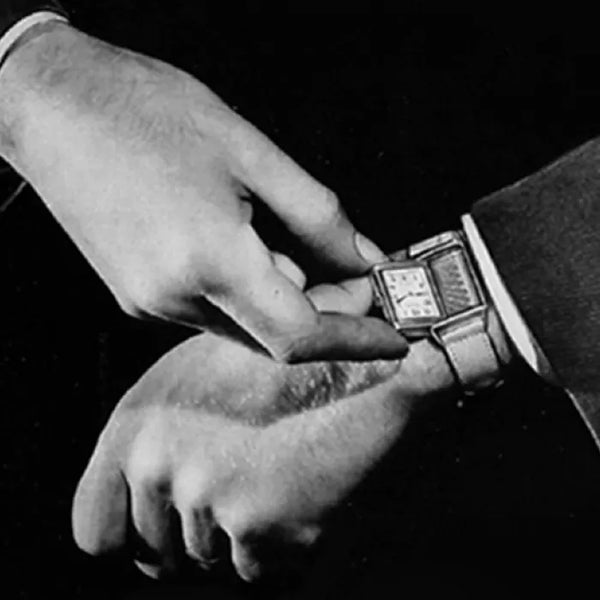 Images courtesy of hodinkee.com
Images courtesy of hodinkee.com
His name, future crown and the year of the planned coronation were engraved on the underside of the case. However, the engraving was done a little too soon. By 1937, Edward was no longer going to be king. Edward announced his abdication on December 11, 1936, cancelling his coronation to share his life with the woman he loved instead of sitting on the British throne alone. Instead, its engraving is a reminder of Edward’s hesitancy right up until the last minute, before he was conquered by the love of an American woman.
Personalization
The Reverso’s smooth “blank page” case-back is an ideal canvas for personalization. Jaeger-LeCoultre artists can transform the case-back into a one-of-a-kind piece of art, discreetly engraving a symbol, a family crest, a monogram or a date.
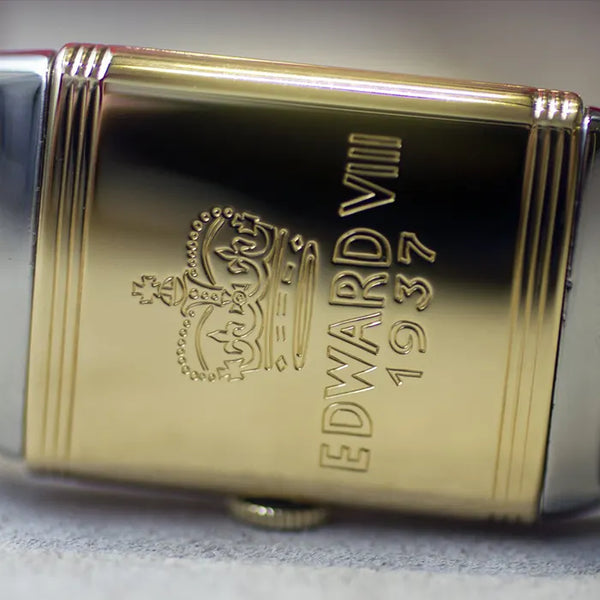 Images courtesy of jaeger-lecoultre.com
Images courtesy of jaeger-lecoultre.com
Jaeger-LeCoultre only allows the most talented craftsmen to mark their watches. To chisel the tiniest details and produce work of the highest precision, master engravers use twelve different burins. They sharpen them before starting each new piece of work, first with a sandstone grinder, then with the emery grinder, and finally with an oil stone. It takes years and years of practice to learn to write on gold, steel, or platinum with a burin.
See how a specialized watchmaker engraves the back of a Reverso watch:
Certain Reverso watches can also be enameled. Highly skilled artisans can reproduce your favorite painting, your portrait or a photo. Enamel miniaturists, working in-house for Jaeger-LeCoultre, have mastered all the traditional techniques of enameling like grand feu, champlevé, translucent, and cloisonné. In addition, they have recently developed an exclusive process, which gives the image extraordinary depth. Just by slightly tilting it under any source of light, a range of color variations are revealed and open up new perspectives and nuances much like a hologram. One of the most famous creations featured the portrait of a beautiful Indian lady, a Maharani, whose story remains one of the best-kept secrets in the history of the Reverso.
You can choose to further customize your Reverso by selecting one of the company’s exceptional watch straps, available in a wide range of rare leathers and precious skins. An almost limitless supply of materials, colors, stitching options and finishes are available for selection. All of Jaeger-LeCoultre’s materials promise a clean, precise and, above all, elegant aesthetic.
Reverso timepieces give new meaning to the phrase “no two are alike.”
Want to learn more about the ultimate choice for a personalized timepiece?
Feel free to come into a Shreve & Co store and explore every one of the Reverso models. All of the staff can discuss the pros and cons of each model and help you personalize it but if you really want to hear more about the history, complications and personalizations visit us in-store. You can also schedule an appointment online today.
